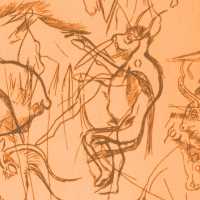
Rock
Art Interpretation
When faced with ancient faded
images many rock art investigators have tried to recreate
what the images must have looked like when new. I
hope DStretch can be useful in this quest. Here is a
slideshow of a few famous researchers and their
interpretations.

El Chavalito is a large Great Mural site in the Sierra de Guadalupe, Baja California Sur. It was one of the first sites I visited in the Sierra de Guadalupe and it made a strong impression on me. The rock art here is fascinating and can be very beautiful. It is a significant site for the study of Great Mural art. In some ways it is a companion site to Los Clavelitos. They are 27 km apart. They are both large sites with hundreds of images in many different Great Mural sub-styles. They are both dominated by a single huge mono. In many other ways the sites differ, especially in the sub-styles that are present. To my mind Chavalito gets the prize for the incredible creativity and variety of its art. It lacks the classic beauty of the art in Sierra de San Francisco (see my slideshow here on sites near Cueva Pintada), but makes up for that with vitality and inventiveness. I visited this site on December 23, 2006 as part of the INAH project: Identidad Social, Comunicación Ritual y Arte Rupestre: El Gran Mural de la Sierra de Guadalupe B.C.S. under the leadership of Maria de la Luz Gutiérrez Martinez.
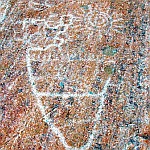
On September 26, 2015 the Sacramento Archaeological Society and FSRA had a field trip to see Style 7 petroglyph sites in the Sierras. We had a unique chance to visit the Chickering site on the North Fork of the American River. Thanks to Dan Foster for organizing the trip and to John Foster for inviting me. John Betts, the premier documenter of Style 7 sites was there. It was great to see him again after many years. DStretch did not always work to enhance the sites, but at Chickering it did well. For more information on northern Sierra petroglyphs visit this link.
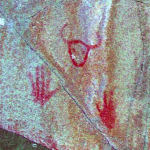
In July, 2013, on a paddle down the St Croix River not far from Minneapolis my wife Sheila noticed some pictographs. I had to borrow a camera, but got photos that I later DStretched. This was an unexpected delight. We later talked with Jean Schaeppi-Anderson, Cultural Resource and Interpretive Specialist, St. Croix National Scenic Riverway about the pictographs. I sent her my enhancements. I hope they help to document this beautiful site.

On the weekend of June 22-23, 2013 BARARA held the Paul Freeman memorial field trip to the Sierras. We visited many sites that Paul had led us to and found a site that Paul had been unable to revisit. It was a great trip. At the Donner Pass petroglyph site DStretch proved its usefulness. I usually discourage users from getting their hopes too high when using DStretch on petroglyphs. This time the pink granite patina gave DStretch a hue difference to enhance. It worked well, even giving some new information not found in the drawings at the site plaque.
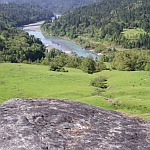
In April 2012 I rafted down the Eel River
with expert river runner Pierre Pelet. We visited a
little known petroglyph site near Coleman Creek. Here I
have put my photos from that trip and another visit in
September 2012. Over the years I have visited other
sites along the Eel and have collected my photos and what
information I have about them.
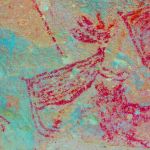
Rincón
de las Cuevas
Harry Crosby visited this site. His description (see
the slideshow for a long quote from his book) is of a very
poorly preserved site, but one that was possibly important
in understanding the northern expansion of the Great Mural
artists. Hoping that DStretch might help I visited
this site in April, 2012. Here are my slides from a
presentation at MORAW, 2013. Since Crosby's
explorations more sites have been found and the northern
sites seem more diverse than his initial definition of
Red-on-Granite. Also of interest are my photos of the
petroglyphs (PCN's?) on the cave floor. 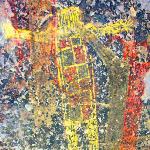
Cueva San Borjitas
San Borjitas is located north of Mulege in Baja California Sur. I originally tested DStretch on images from my first San Borjitas visit (see the Sierra de Guadalupe slideshow below). I returned to San Borjitas in January 2010. I didn't realize how impressive and important this site was until I DStretched my new images. They are truly amazing. DStretch brings out beautiful colors and fascinating details of the rock art. This site is one of the most impressive in all of North America. This photography was done as part of a project by INAH archaeologist Maria de la Luz Gutiérrez Martinez in the Sierra de San Francisco and Guadalupe. 2010 presentations about San Borjitas 2011 presentations about San Borjitas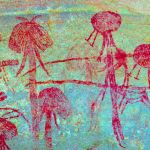
Masange A13
Masange A13 is in the Kondoa
Rock Art World Heritage Site in Central Tanzania.
The Kondoa sites were documented by Mary Leakey in her
book "Africa's Vanishing Art". Perhaps "Africa's
Forgotten Art" would be a better modern title since the
sites receive little visitation and there are no ongoing
conservation or documentation projects. Leakey does
not document Masange in her book, but this site contains
beautiful painted images. The headresses on the human
figures are amazing with fascinating details.
Recent vandalism at the site makes it important that the
conservation and documentation of this important rock art
should be continued. Our guide from the Tanzania
Antiquities Department was Maulidi Rauna. My wife
Sheila and I visited the site on September 18, 2009. I
gave this presentation at ARARA 2010 in Del Rio, Texas.
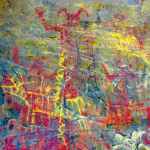
Los Clavelitos
This is a large and important
site in the southern Sierra de Guadalupe, Baja California
Sur. INAH archaeologist Maria
de la Luz Gutiérrez Martinez
has a project to document and protect the sites in this
sierra that are not yet open to the public. As part
of her project I photographed several sites in late
2007. To give the viewer some sense of the context
of the images I have tried a new slide show format with
index images that show the positions of the
photographs. We were accompanied by INAH custodian
Aaron Real Villavicencio and translator Ayla Perez.
Del Cover wrote a very fine paper about this site in 1990
and I have included scans of the paper with his
permission.
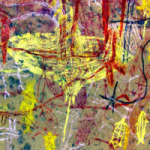
El Dipugón
El Dipugón is a relatively
small rockshelter in the Sierra de Guadalupe. I
visited it as part of the project by INAH archaeologist Maria
de la Luz Gutiérrez Martinez.
Our local guide was Placido Osuna Villavicencio. The
several hour mule trip from Placido's rancho was made more
interesting by the constant gentle equipatas rain.
The painting in this rockshelter is wonderfully well
preserved. An amazing cast of creatures are drawn in
many colors. Perhaps an ichthyologist out there can
help with the identification.
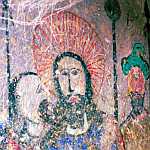
La Capilla Enterrada
Near Zapotitlan Salinas in
the state of Puebla, Mexico is an abandoned chapel dug
into the ground. The murals on the walls and ceiling
of the chapel are fantastic and seem different than what
might be expected in a Catholic church.
Unfortunately they have been vandalized, have faded and
are covered with bird droppings. In August 2007
Sheila and I visited the chapel accompanied by INAH
archaeologist Antonio Porcayo Michelini and local guide
Pedro Guadalupe Miranda Pacheco.
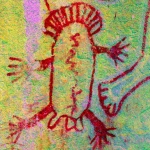
Rocky Hill
BARARA (Bay Area Rock Art Research Association) visited Tulare County Yokuts pictograph sites in March 2006. The highpoint of our trip was a visit to Rocky Hill near Exeter. This site has been preserved by the Archaeological Conservancy. Docent Manuel Andrade gave us an excellent tour. I got a great chance to try out DStretch on the beautiful pictographs. DStretch CRGB does really well on the red pignents.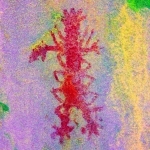
Tulare County Yokuts Sites
On our BARARA trip in March we were lucky to have the expert guidence of Jim and Mary Gorden who took us to the Buena Vista and Bacon Hill sites. Here DStretch also did very well, bringing out some fantastic images that were a surprise to us all.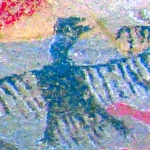
Cueva Pintada Trip
In June 2005 Sheila and I visited Cueva Pintada on a trip led by Elanie Moore. It was hot! Eve Ewing kindly provided me with reprints of papers by herself, Elanie, and others that analyzed the caves. It was fascinating to read the papers with the paintings right in front of me. This sparked my own thinking about the mural composition. Here I show some images from Pintada and other sites we visited on the trip.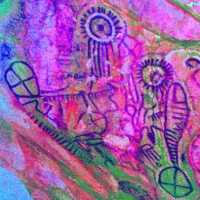
Mysterious Creature of Burham Canyon
When using DStretch on scans of photos I had taken years ago (1992), I discovered a creature I had never known was there. Is the creature really there? I'll have to revisit the site to find out. The site is KER-273. We had a hard time finding it the first time, after all these years I wonder if I can find it again. Update:I revisited the site on a KCAS trip in 2010 led by Jack Sprague, so no trouble finding the site.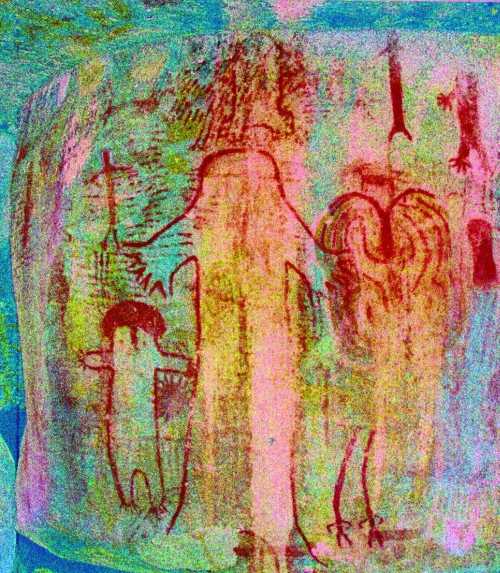
Tule River Painted Rock
This is a special site with
beautiful pictographs. It has been studied since the
late 1800's. The CRGB matrix does a great job of
clarifying the pictograph compositions.
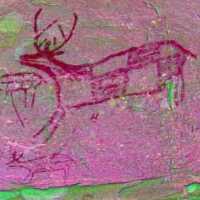
First
Visits to Trinidad and San Borjitas
I first visited Cueva La
Trinidad in 2003 and Cueva San Borjitas in 2004.
Both times my guide was Salvador Castro Drew from
Mulege. They are incredible caves and provide
interesting images for DStretch. Elsewhere on this
site I use other San Borjitas images. They are some
of my favorites -- see the San Borjitas
slideshow. Usually the name is given as San
Borjitas, but Salvador insisted it should be San Borjita.
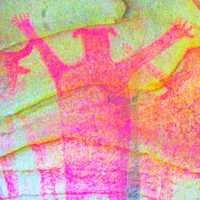
Santa
Gertrudis Mule Trips
I have been on several mule trips in the area around Mission
Santa Gertrudis, Baja California. The trips were
organized by Eve Ewing, an expert on Baja California rock
art. Our guide was Arturo Villavicencio, one of the
best guides in Baja. We explored well known sites and
looked for new ones. Many of the sites we found were
very faded. DStretch can make a huge difference in
visualizing the old faded images.
Tassili N' Ajjer
The Tassili Plateau rises above the Sahara Desert in
Algeria. Documented first by Henri Lhote in the 1950's
the rock art here spans thousands of years and goes back to
times when the Tassili had much more water than now. I
visited the Tassili Plateau in 1990. My slideshow was
originally done early in the history of DStretch. I
have updated it a little in 2015.